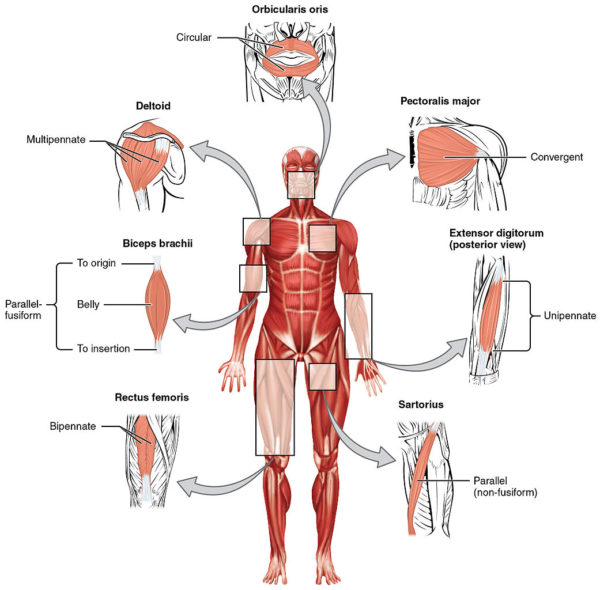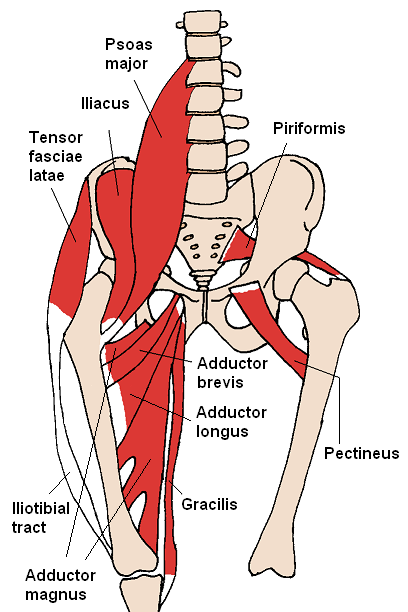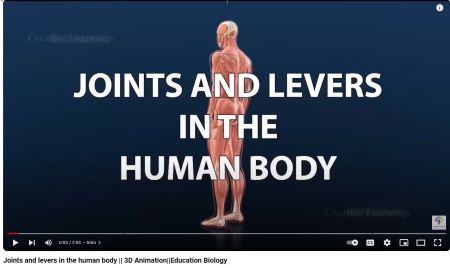Muscles & bone work like a lever machine
As you study human muscles you will hear that they work with bone as levers. But what does that mean? How does a lever machine work?
It can be difficult to connect memorizing the origin, and insertion points of muscles on bones with the concept of leverage. So, let’s try to sort how muscles work as levers now.
3 Types of levers
Muscles pulling on bone work like one of the 3 types of levers displayed below.
Muscle & Bone Levers
In anatomy, muscle and bone levers consist of bone [a rigid bar] that pivots at an anatomical structure that acts as a hinge or a point of support [a fulcrum] and moves a weight [load] at one end or at the midpoint of the bar by applying a muscle contraction [force].
Thinking of muscles and bones as a set of levers helps to clarify how an array of angular movements can be accomplished by cells, skeletal muscle fibers, that work only linearly.
The angle of muscle fibers relative to the muscle’s tendon assists in converting linear to non-linear movement. The arrangement of muscle origins and insertion points on bone is also important for fine-tuning the direction of motion. Lever arrangements, judicious use of insertions and points of origin, and an assortment of muscle sizes and shapes produce precise performance.

Various shapes used by skeletal muscle to convert linear into angular movement, OpenStax College/Wikimedia Commons
Muscle origins and insertions
Each muscle has an origin and an insertion point. Muscle origins and insertions can be described as the anchor end [origin] and the most mobile end [insertion] when the muscle shortens.
A muscle’s origin is usually at the attachment of its tendon to the bone with greater mass and stability. Bones at the origin of a muscle are typically those nearer the axis of the skeleton, proximal. The bone at a muscle’s insertion point is usually lighter and distal.
The illustration below displays the origins and insertions of the anterior hip muscles. Here the origins are the spinal column and hip bone. The insertion points are on the bones of the legs. As the muscles contract the legs move.
But sometimes muscle insertions are on soft tissues. For example, the orbicularis oris muscle, an oval shaped muscle, inserts on the skin around the lips and has its origin on the maxilla and mandible.
Learning the origin and insertion points of various muscles is much easier if bones are well-learned first. Bones appear a bit boring without something attached to them, but it is well worth going back and reviewing the size, shape and location of the larger bones before trying to learn muscle origins and insertions.
The best way to study muscle origins and insertions is to keep in mind the shape of the muscle and its tendons. Long thin tendons are likely to attach to lighter, thinner, distal bones as insertions. Thicker broader tendons make much better anchors and are found proximal as muscle origins.
Examples of human muscle and bone levers
This video by Bob Myers describes specific examples of muscle and bone arrangements that work as the 3 types of levers to make the body mobile.
Further reading
Do you have questions?
Please put your questions in the comment box or contact Dr. Reece directly at DrReece@MedicalScienceNavigator.com, or on Pinterest, or on LinkedIn.
Margaret Thompson Reece PhD, Physiologist, Medical Research Scientist and Laboratory Director during over 20 years in OB/Gyn clinical departments at academic medical centers in California, New York and Massachusetts, is now Manager at Reece Biomedical Consulting LLC.
Asna educator, she taught physiology for over 30 years to undergraduate and graduate students, at two- and four-year colleges and universities, in the classroom and in the research laboratory.
Experience taught here that the best way for premed students to get the B+ or better grade in A&P that is required for acceptance to medical training, the first time through the course, is to describe body processes on exams in terms of neural, cardiovascular, and endocrine involvement.
Her books help A&P students struggling to master the chemistry of human physiology. They are “Physiology: Custom-Designed Chemistry” and “Inside the Closed World of the Brain.” More about her books is available at https://www.amazon.com/author/margaretreece.
For those preferring video training, she offers an online course “30-Day Challenge: Craft Your Plan for Learning Physiology”
Dr. Reece offers a free 30 minute “how-to-get-started” phone conference to students struggling with human anatomy and physiology. Schedule an appointment by email at DrReece@MedicalScienceNavigator.com.




